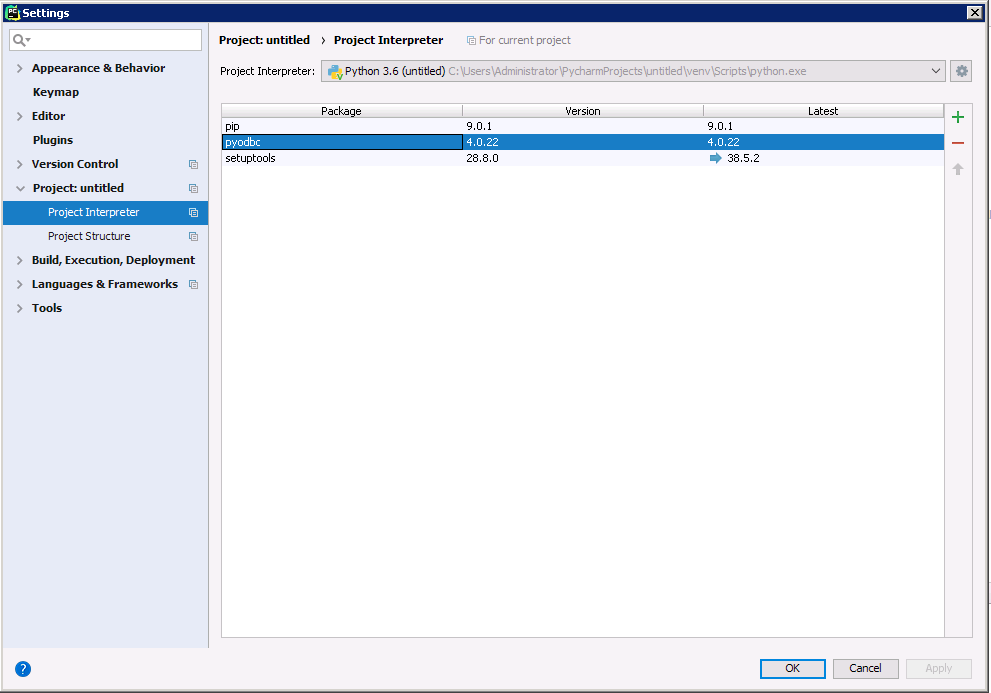Discover how a bimodal integration strategy can address the major data management challenges facing your organization today.
Get the Report →Using the CData ODBC Driver for Zoom in PyCharm
Connect to Zoom as an ODBC data source in PyCharm using the CData ODBC Driver for Zoom.
The CData ODBC Drivers can be used in any environment that supports loading an ODBC Driver. In this tutorial we will explore using the CData ODBC Driver for Zoom from within PyCharm. Included are steps for adding the CData ODBC Driver as a data source, as well as basic PyCharm code to query the data source and display results.
To begin, this tutorial will assume that you have already installed the CData ODBC Driver for Zoom as well as PyCharm.
Add Pyodbc to the Project
Follow the steps below to add the pyodbc module to your project.
- Click File -> Settings to open the project settings window.
- Click Project Interpreter from the Project: YourProjectName menu.
- To add pyodbc, click the + button and enter pyodbc.
- Click Install Package to install pyodbc.

Connect to Zoom
You can now connect with an ODBC connection string or a DSN. See the Getting Started section in the CData driver documentation for a guide to creating a DSN on your OS.
Start by setting the Profile connection property to the location of the Zoom Profile on disk (e.g. C:\profiles\Zoom.apip). Next, set the ProfileSettings connection property to the connection string for Zoom (see below).
Zoom API Profile Settings
To authenticate to Zoom, you can use the OAuth standard to connect to your own data or to allow other users to connect to their data.
First you will need to create an OAuth app. To do so, navigate to https://marketplace.zoom.us/develop/create and click Create under the OAuth section. Select whether or not the app will be for individual users or for the entire account, and uncheck the box to publish the app. Give the app a name and click Create. You will then be given your Client Secret and Client ID
After setting the following connection properties, you are ready to connect:
- AuthScheme: Set this to OAuth.
- InitiateOAuth: Set this to GETANDREFRESH. You can use InitiateOAuth to manage the process to obtain the OAuthAccessToken.
- OAuthClientID: Set this to the OAuth Client ID that is specified in your app settings.
- OAuthClientSecret: Set this to the OAuth Client Secret that is specified in your app settings.
- CallbackURL: Set this to the Redirect URI you specified in your app settings.
Below is the syntax for a DSN:
[CData API Source]
Driver = CData ODBC Driver for Zoom
Description = My Description
Profile = C:\profiles\Zoom.apip
Authscheme = OAuth
OAuthClientId = your_client_id
OAuthClientSecret = your_client_secret
CallbackUrl = your_callback_url
Execute SQL to Zoom
Instantiate a Cursor and use the execute method of the Cursor class to execute any SQL statement.
import pyodbc
cnxn = pyodbc.connect('DRIVER={CData ODBC Driver for API};Profile = C:\profiles\Zoom.apip;Authscheme = OAuth;OAuthClientId = your_client_id;OAuthClientSecret = your_client_secret;CallbackUrl = your_callback_url;')
cursor = cnxn.cursor()
cursor.execute("SELECT Id, JobTitle FROM MeetingRegistrants WHERE State = 'NC'")
rows = cursor.fetchall()
for row in rows:
print(row.Id, row.JobTitle)
After connecting to Zoom in PyCharm using the CData ODBC Driver, you will be able to build Python apps with access to Zoom data as if it were a standard database. If you have any questions, comments, or feedback regarding this tutorial, please contact us at support@cdata.com.






